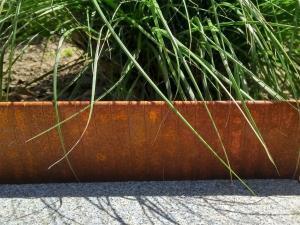What is Cor-ten steel?
Corten steel – a unique metal alloy
What is Corten steel?
COR-TEN steel, the original name of this steel grade, is the name associated with a metal alloy with iron as a base after which phosphorus, copper, nickel, chromium and silicon are added. Nevertheless, the strength of this steel grade is comparable to other alloy steels such as stainless steel. The material is easily recognised by its typical rust colour. Many metals oxidise, only precious metals such as gold and platinum hardly oxidise at all. The oxide that forms on the outside of metal protects the underlying metal from oxygen. This protects the metal under the oxide skin from corrosion. The metal protects itself, so to speak, by developing oxide. Corten steel contains a thick oxide skin, which protects the metal underneath the oxide, making the material corrosion-resistant and guaranteeing a long lifespan. Moreover, the metal does not need additional treatment with a layer of paint or coating, as the protective layer forms a shield against harsher weather conditions such as rain, snow and sleet. Corten steel is therefore widely used for metal objects standing outside in all weathers.
The advantages of Corten steel
There are several advantages to Corten steel that make it attractive to use this material. One major advantage of Corten steel is that it lasts up to 10x longer than regular steel. This not only shows that it is a particularly strong material, but at the same time it proves its durability. Other advantages are that Corten steel does not need to be treated with maintenance products and that it is 100% recyclable. A practical material, in other words! Moreover, the material is easily available, it radiates warmth and weighs little. This makes the material attractive both in appearance and weight. So it is a great material to buy in a garden fireplace, for example! However, there is also a downside. Besides its many advantages, Corten steel also has some disadvantages. For instance, the material has to go through a cycle of dry and wet weather conditions to build up a really solid protective layer. So it takes some time and the right weather conditions to achieve the desired effect, but this does not have to be an immediate disadvantage in Belgium.


